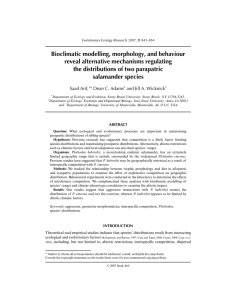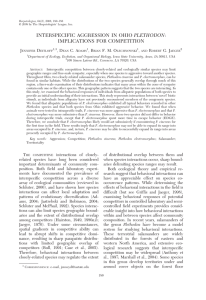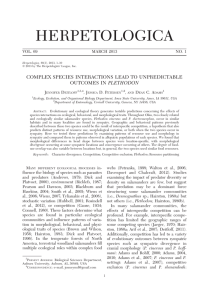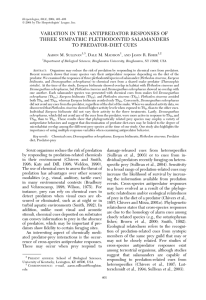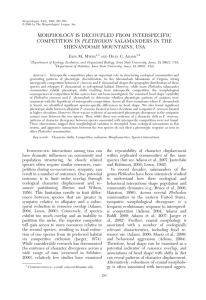Notice warning concerning copyright restrictions
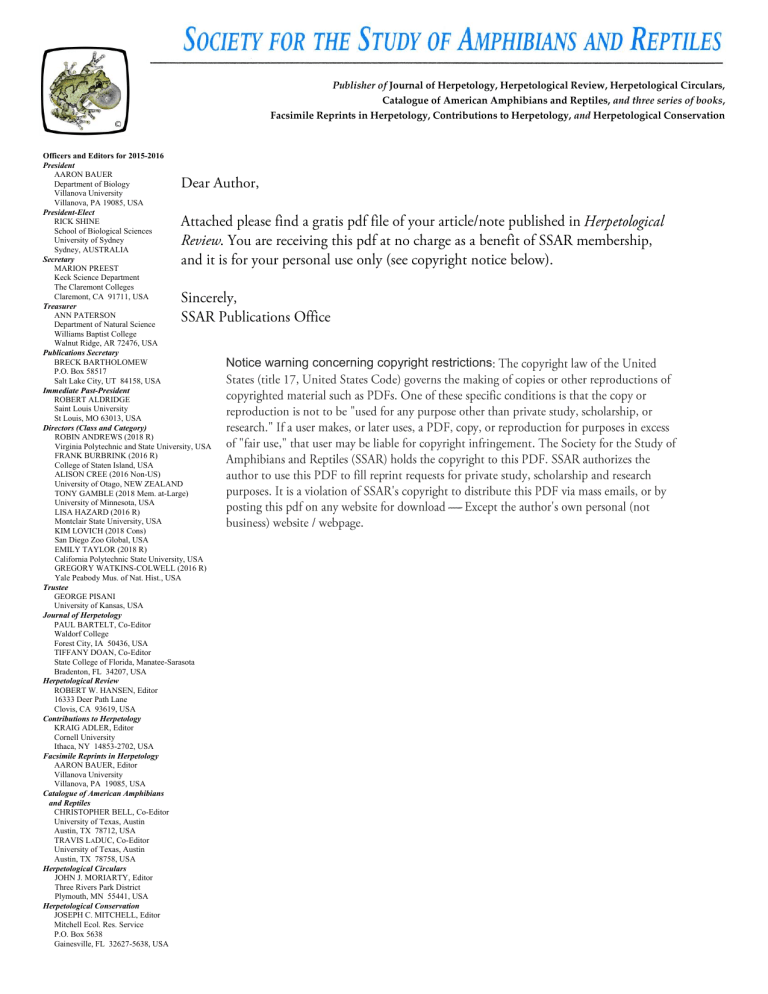
Publisher of Journal of Herpetology, Herpetological Review, Herpetological Circulars,
Catalogue of American Amphibians and Reptiles, and three series of books ,
Facsimile Reprints in Herpetology, Contributions to Herpetology, and Herpetological Conservation
Officers and Editors for 2015-2016
President
AARON BAUER
Department of Biology
Villanova University
Villanova, PA 19085, USA
President-Elect
RICK SHINE
School of Biological Sciences
University of Sydney
Sydney, AUSTRALIA
Secretary
MARION PREEST
Keck Science Department
The Claremont Colleges
Claremont, CA 91711, USA
Treasurer
ANN PATERSON
Department of Natural Science
Williams Baptist College
Walnut Ridge, AR 72476, USA
Publications Secretary
BRECK BARTHOLOMEW
P.O. Box 58517
Salt Lake City, UT 84158, USA
Immediate Past-President
ROBERT ALDRIDGE
Saint Louis University
St Louis, MO 63013, USA
Directors (Class and Category)
ROBIN ANDREWS (2018 R)
Virginia Polytechnic and State University, USA
FRANK BURBRINK (2016 R)
College of Staten Island, USA
ALISON CREE (2016 Non-US)
University of Otago, NEW ZEALAND
TONY GAMBLE (2018 Mem. at-Large)
University of Minnesota, USA
LISA HAZARD (2016 R)
Montclair State University, USA
KIM LOVICH (2018 Cons)
San Diego Zoo Global, USA
EMILY TAYLOR (2018 R)
California Polytechnic State University, USA
GREGORY WATKINS-COLWELL (2016 R)
Yale Peabody Mus. of Nat. Hist., USA
Trustee
GEORGE PISANI
University of Kansas, USA
Journal of Herpetology
PAUL BARTELT, Co-Editor
Waldorf College
Forest City, IA 50436, USA
TIFFANY DOAN, Co-Editor
State College of Florida, Manatee-Sarasota
Bradenton, FL 34207, USA
Herpetological Review
ROBERT W. HANSEN, Editor
16333 Deer Path Lane
Clovis, CA 93619, USA
Contributions to Herpetology
KRAIG ADLER, Editor
Cornell University
Ithaca, NY 14853-2702, USA
Facsimile Reprints in Herpetology
AARON BAUER, Editor
Villanova University
Villanova, PA 19085, USA
Catalogue of American Amphibians
and Reptiles
CHRISTOPHER BELL, Co-Editor
University of Texas, Austin
Austin, TX 78712, USA
TRAVIS L A DUC, Co-Editor
University of Texas, Austin
Austin, TX 78758, USA
Herpetological Circulars
JOHN J. MORIARTY, Editor
Three Rivers Park District
Plymouth, MN 55441, USA
Herpetological Conservation
JOSEPH C. MITCHELL, Editor
Mitchell Ecol. Res. Service
P.O. Box 5638
Gainesville, FL 32627-5638, USA
Notice warning concerning copyright restrictions
70 NATURAL HISTORY NOTES
F ig
. 2. An adult Japanese Giant Salamander (Andrias japonicus) regurgitating the embryo of a Sika Deer (A and B) and finally expelling it (C), on a handmade scale.
afterward. The embryo was 360 mm in length and weighed 1100 g. After measurements, we injected a PIT tag into the left shoulder of the giant salamander and released it to the main stream of the Sayo River (35.05750°N, 134.36694°E, datum WGS84; elev. 145 m). The embryo was probably discarded in the river by a hunter.
YUKARI MATSUSHITA (e-mail: menosira@poporo.ne.jp), OSAMU YA-
MAKAWA (e-mail: y.osamu@viola.ocn.ne.jp), HIROKAZU ONUMA (e-mail: hadakasu@poporo.ne.jp), The Nature Conservation Society of Hyogo Prefecture, 2-1-18 Goko-dori, Chuo-ku, Kobe, Hyogo 651-0087, Japan; KAN-
TO NISHIKAWA, Graduate School of Human and Environmental Studies,
Kyoto University, Yoshida Nihonmatsu-cho, Sakyo-ku, Kyoto 606-8501, Japan (e-mail: hynobius@zoo.zool.kyoto-u.ac.jp); MASAHARU MOTOKAWA
(e-mail: motokawa.masaharu.6m@kyoto-u.ac.jp) and TAKASHI YATO (email: runchorosan@zoo.zool.kyoto-u.ac.jp), The Kyoto University Museum,
Yoshida Hon-machi, Sakyo-ku, Kyoto 606-8501, Japan.
CRYPTOBRANCHUS ALLEGANIENSIS ALLEGANIENSIS (Eastern Hellbender).
LARVAL/ADULT ASSOCIATION.
Hellbenders are generally considered solitary animals with a single animal primarily found under one rock throughout most seasons
(Smith 1907. Biol. Bull. 13:5–30; Nickerson and Mays 1973. The
Hellbenders. Milwaukee Public Museum, Milwaukee, Wisconsin.
106 pp.). However, during the breeding season more than one hellbender can be found under the same rock (Smith 1907, op.
cit.; Bishop 1941. New York State Mus. Bull. 324:1–365; Peterson
1988. Herpetol. Rev. 19:28–29). Further, the fact that hellbenders are cannibalistic is well known (Nickerson and Mays 1973, op.
cit.; Groves and Williams 2014. Herpetol. Rev. 45:108–109) and might explain the rare instance of more than one hellbender under the same rock when breeding season activities are not apparent. Most reported occurrences of hellbenders sharing a single rock outside the breeding season generally refer to adults of undetermined sizes and sexes (Smith 1907, op. cit.; Hillis and Bellis
1971. J. Herpetol. 5:121–126; Nickerson and Mays 1973, op. cit.).
Because few intraspecific associations of hellbenders of differing age classes have been reported, the following observations are of interest. In each case the specific locality is withheld due to conservation concerns.
On 13 March 2004 in the Hiwassee River drainage, Union Co.,
Georgia, USA, we encountered an adult male C. a. alleganiensis
(total length = 37.5 cm) under a rock (c. 0.5 x 0.5 m) with four conspecific larvae. The average total length of the larvae was
3.93 cm (range: 3.8–4.0 cm), and all larvae had noticeable yolk sacs, external gills, well-developed forelimbs, and small hind limbs. Based upon records of oviposition and nest guarding behavior occurring in September at this site (Jensen et al. 2004.
Herpetol. Rev. 35:156), and given a 60–80 day incubation period
(Hulse et al. 2001. Amphibians and Reptiles of Pennsylvania and the Northeast. Cornell University Press, New York. 419 pp.), it is possible these larvae hatched rather late in the season, within two–three weeks of this observation. However, little is known about embryonic development in the wild and what environmental factors affect development over winter.
On 29 June 2010 in the French Broad River drainage,
Transylvania Co., North Carolina, USA, we collected an adult male C a. alleganiensis (total length = 42 cm) from under a large, flat rock measuring 1.2 x 1.2 m. Shortly after collecting the adult male, a small, gilled larval hellbender (total length = c. 5 cm) was observed walking and swimming from under the same rock. This rock was in run habitat with 0.5 m water depth and approximately 50–60 m from a large pool at the base of a small waterfall. The larva did not appear to be stressed or injured.
After emerging from under the rock, the larva circled and walked back under it in the same area that the adult male returned to upon release. We were unable to capture this larva for processing before it re-entered the large rock.
In a final example, on 08 August 2012 in the Hiwassee River drainage, Cherokee Co., North Carolina, USA, we collected an adult male C. a. alleganiensis (total length = 37 cm) from under a large, flat rock measuring 1.2 x 2.1 m in size. During the capture, a gilled larva (total length = 7 cm) was swept into a net positioned on the downstream side of the rock. We noticed no injuries on the larva during processing. The rock was in run habitat with 0.3 m water depth and in a river section with bedrock and sand as the predominant substrate. After processing, both the adult male and the gilled larva were placed at the downstream entrance to the capture rock, where they both crawled back under and remained.
Although we cannot determine how long the larvae from each observation occupied the same rocks as the adult males, it is possible that the larvae were remaining young from the previous season’s brood and were still being protected under their natal rocks by the adult males. The size of the larvae suggests that they
Herpetological Review 46(1), 2015
NATURAL HISTORY NOTES 71
were less than one year of age (Bishop 1941, op. cit.; Nickerson and Mays 1973, op. cit.), which supports this hypothesis.
Another possibility is that shelter rocks had separate cavities or compartments within that provided the larvae refuge from being in direct contact with the adults and were thus able to avoid being cannibalized. A third alternative that must be considered is that the larvae observed in the latter two observations may have entered the rocks of the adult males opportunistically immediately prior to our surveys. The hellbender populations at our three localities are robust and appear to be stable which could increase the chance of larval/adult associations.
We thank Shem Unger for encouraging us to report these observations.
JOHN D. GROVES, North Carolina Zoological Park, 4401 Zoo Parkway,
Asheboro, North Carolina 27205, USA (e-mail: johngroves2005@yahoo.
com); LORI A. WILLIAMS, North Carolina Wildlife Resources Commission,
177 Mountain Laurel Lane, Fletcher, North Carolina 28732, USA (e-mail: lori.
williams@ncwildlife.org); SEAN P. GRAHAM, Sul Ross State University, Department of Biology, Geology, and Physical Sciences, Alpine, Texas 79832,
USA (e-mail: sean.graham@sulross.edu).
PLETHODON CINEREUS (Eastern Red-backed Salamander).
MOVEMENT.
Lungless salamanders (family Plethodontidae) are relatively sedentary and are presumed to have limited dispersal ability (Marsh et al. 2004. Ecology 85:3396–3405). Site fidelity in Plethodontidae is high, and individuals displaced 90 m return to home territories (Kleeberger and Werner 1982. Copeia
1982:409–415). Individuals defend territories (Jaeger et al. 1982.
Anim. Behav. 30:490–496) and female home ranges have been estimated to be 24.34 m 2 (Kleeberger and Werner 1982, op. cit.). Females may seek out suitable subsurface habitat to oviposit eggs, yet little is known about their maximum movement distances
(Petranka 1998. Salamanders of the United States and Canada.
Smithsonian Institution Press, Washington. 587 pp.).
On 18 September 2014, a female P. cinereus (lead back morphotype; SVL = 44.68 mm; 0.89 g) was found under a coverboard during a standard sampling event and uniquely marked using visual implant elastomer at the S.O. Conte
Anadromous Fish Research Center, Massachusetts, USA
(42.59280°N, 72.58070°W, datum WGS84; elev. 74 m). This individual was subsequently recaptured at ~1500 h on 8 October
2014 under a coverboard within 3 m of the original capture location and then again ~1430 h on 16 October 2014 under a log, within the same forest patch, though in a 50 x 150 m area adjacent to the original study area. Because we found the marked salamander while collecting multiple individuals for a laboratory study, the exact recapture location of the marked individual is not known. However, the distance between the 8 October capture location and the nearest edge of the 16 October search area (i.e. 50 x 150 m) was 143 m, indicating a minimum movement distance.
As far as we are aware, this is the longest recorded movement for P. cinereus by more than 53 m (Kleeberger and Werner 1982,
op. cit.). This finding followed a rain event of 1.63 cm within 24 h and the second largest sustained rain event during October. The movement we observed may have been due to disturbance from handling and marking, although this was minimized in the field.
SEAN C. STERRETT (e-mail: seansterrett@gmail.com), ADRIANNE B.
BRAND, WILLIAM R. FIELDS, RACHEL A. KATZ, EVAN H. CAMPBELL
GRANT, United States Geological Survey, Northeast Amphibian Research and Monitoring Initiative, Patuxent Wildlife Research Center, SO Conte
Anadromous Fish Research Laboratory, One Migratory Way, Turners Falls,
Massachusetts 01376, USA.
PLETHODON HUBRICHTI (Peaks of Otter Salamander).
BE-
HAVIOR.
On 13 September 2014, while examining a site located near Onion Mountain, Bedford Co., Virginia, USA, where
Plethodon hubrichti and P. cinereus are sympatric, we discovered a P. hubrichti (SVL ca. 48 mm) biting a P. cinereus (SVL ca. 30 mm) beneath a rock on the forest floor (Fig. 1). The P. cinereus visibly struggled during our observation with no noticeable effect on the P. hubrichti. The P. hubrichti appeared to have complete physical dominance over the P. cinereus. After a couple of minutes of observation, the P. hubrichti released its grasp and both salamanders retreated to the leaf litter. Both salamanders appeared to be unharmed.
Interference competition with P. cinereus, including agonistic behavior and territoriality, is thought to be a factor influencing the range boundaries of several Plethodontid species, including
P. hubrichti (Arif et al. 2007. Evol. Ecol. Res. 9:843–854). The range of P. hubrichti is limited to a 19-km length of the Blue Ridge
Mountains in Virginia and it is sympatric with the wide-ranging P.
cinereus along the edge of its range (Petranka 1998. Salamanders of the United States and Canada. Smithsonian Institution Press,
Washington, DC. 587 pp.). Aggressive behaviors, such as lunging and biting, have been documented between P. hubrichti and
P. cinereus; however, most behavior studies take place in the laboratory and these behaviors are rarely observed in the field.
Although there is no dietary evidence that suggests P. hubrichti regularly consumes other salamanders (Arif et al. 2007, op. cit.) the size difference between the observed individuals suggests that the P. hubrichti was capable of swallowing the P. cinereus.
F ig
. 1. Plethodon hubrichti biting a smaller P. cinereus.
ANDREW KNIOWSKI, Department of Fish and Wildlife Conservation,
Virginia Tech, Blacksburg, Virginia 24061, USA (e-mail: kniowski@vt.edu);
RENÉE PIETSCH, Department of Biological Sciences, Virginia Tech, Blacksburg, Virginia 24061, USA.
TRITURUS MACEDONICUS ( Macedonian Crested Newt).
TAIL
AUTOTOMY.
Tail autotomy is one of many anti-predator adaptations and is particularly common in lizards (e.g., Arnold 1988. In
Gans and Huey [eds.], Biology of the Reptilia, Vol. 16, pp. 253–273
Alan R. Liss, New York; Bateman and Fleming 2009. J. Zool. 277:1–
14). The tail plays an important role in defensive behavior in salamanders: it may be elevated, undulated, and wagged or convoluted, and autotomized (Brodie 1977. Copeia 1977:523–535;
Jablonski and Balej 2014. Herpetol. Rev. 45:302–303). However, tail loss can result in loss of fitness as many animals, including
Herpetological Review 46(1), 2015






